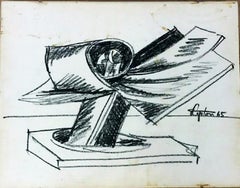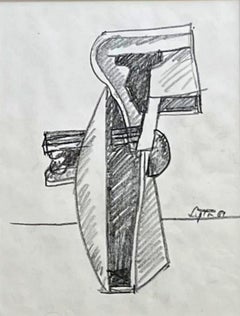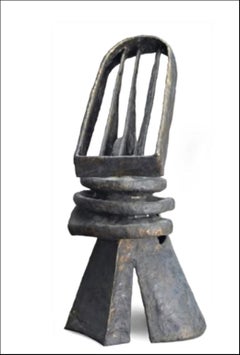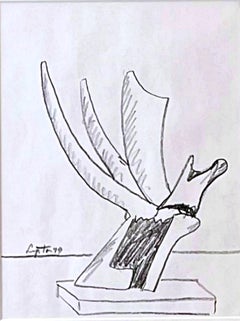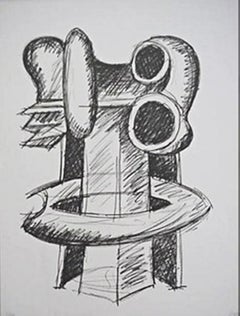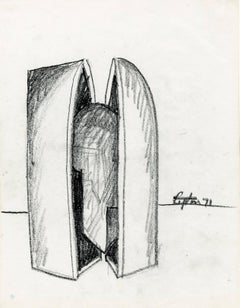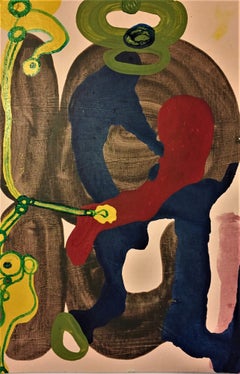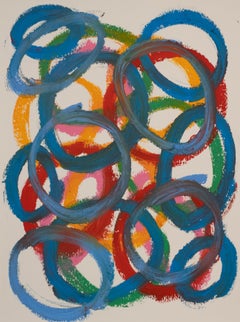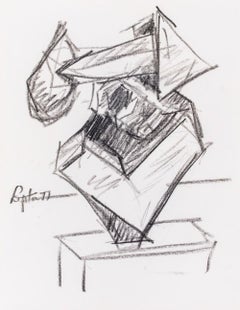Seymour Lipton Art
American, 1903-1986
Seymour Lipton was an American abstract expressionist sculptor. He was a member of the New York School who gained widespread recognition in the 1950s. His early choices of medium changed from wood to lead and then to bronze, and he is best known for his work in metal. He made several technical innovations, including brazing nickel-silver rods onto sheets of Monel to create rust resistant forms. Through the medium of metal sculpture, Lipton endeavored to portray the inner complexities of the human psyche through shapes that enclose and oppose each other, interrelating convex and concave, solid and hollowed forms. Although his imagery was often based on visual stimuli, his expressive abstractions were never literal translations of the visible world. He altered and arranged shapes to create sculptures symbolizing intangible, universal concepts absorbed from sociology, psychology, and myth.to
6
2
Overall Width
to
Overall Height
to
8
2
2
2
1
8
6
1
4
2
1
1
1
8
9,958
2,750
1,376
1,371
3
8
Artist: Seymour Lipton
Study for Pacific Bird Sculpture, Crayon on paper, signed, Marlborough-Gerson
By Seymour Lipton
Located in New York, NY
Seymour Lipton
Study for Pacific Bird Sculpture, 1965
Crayon on paper (Hand Signed & Dated, in Kulicke Frame w/Marlborough-Gerson gallery label)
Signed and dated on center right rect...
Category
Mid-20th Century Abstract Expressionist Seymour Lipton Art
Materials
Crayon
Sculptural study, unique signed charcoal drawing, by renowned modernist sculptor
By Seymour Lipton
Located in New York, NY
SEYMOUR LIPTON
Seymour Lipton
Untitled sculptural study, 1981
Charcoal on paper
hand signed and dated in charcoal pencil on the front
Framed
Original drawing done in charcoal by reno...
Category
1980s Abstract Expressionist Seymour Lipton Art
Materials
Charcoal
Maquette for Laureate (unique sculpture)
By Seymour Lipton
Located in New York, NY
Seymour Lipton
Maquette for Laureate, ca. 1968-1969
Nickel silver on monel metal
Unique
18 × 8 1/2 × 7 inches
Marlborough-Gerson Gallery, New York
Acquired from the above by the previous owner, 1969
thence by descent
Christie's New York: Monday, June 30, 2008 [Lot 00199]
Acquired from the above Christie's sale This unique sculpture by important Abstract Expressionist sculptor Seymour Lipton is a maquette of the monumental sculpture "Laureate" - one of Lipton's most iconic and influential works located on the Riverwalk in downtown Milwaukee, Wisconsin. Laureate is a masterpiece that was commissioned by the Allen-Bradley Company in memory of Harry Lynde Bradley and as an enhancement for the newly constructed Performing Arts Center. It is located on the east bank of the Milwaukee River at 929 North Water Street. The Bradley family in Milwaukee were renowned patrons of modernist sculpture, known for their excellent taste who also founded an eponymous sculpture park. For reference only is an image of the monumental "Laureate" one of Milwaukee's most beloved public sculptures. According to the Smithsonian, which owns a different unique variation of this work, "The full-size sculpture Laureate was commissioned by the Marcus Center for the Performing Arts in Milwaukee. In the initial drawings, Seymour Lipton combined details from the architectural plan with a wide variety of images, ranging from musical instruments to a lighthouse on the island of Tobago. He transformed the basic shapes from these sketches into a welded sculpture, which evokes a figure composed of columns, harp strings, and coiled rope. Lipton created this piece to celebrate achievement in the arts. The dramatic silhouette commands your attention, reflecting the title Laureate, which means worthy of honor and distinction. The final version of the piece is over twelve feet high and stands out against the pale, flat buildings of the arts center.,,"
Provenance
Marlborough-Gerson Gallery, New York
Acquired from the above by the previous owner, 1969
thence by descent
Christie's New York: Monday, June 30, 2008 [Lot 00199]
Acquired from the above Christie's sale
About Seymour Lipton:
Born in New York City in 1903, Seymour Lipton (1903-1986) grew up in a Bronx tenement at a time when much of the borough was still farmland. These rural surroundings enabled Lipton to explore the botanical and animal forms that would later become sources for his work. Lipton’s interest in the dialogue between artistic creation and natural phenomena was nurtured by a supportive family and cultivated through numerous visits to New York’s Museum of Natural History as well as its many botanical gardens and its zoos. In the early 1920s, with the encouragement of his family, Lipton studied electrical engineering at Brooklyn Polytechnic Institute and pursued a liberal arts education at City College. Ultimately, like fellow sculptor Herbert Ferber, Lipton became a dentist, receiving his degree from Columbia University in 1927. In the late 1920s, he began to explore sculpture, creating clay portraits of family members and friends.
In addition to providing him with financial security, dentistry gave Lipton a foundation in working with metal, a material he would later use in his artwork. In the early 1930s, though, Lipton’s primary sculptural medium was wood. Lipton led a comfortable life, but he was also aware of the economic and psychological devastation the Depression had caused New York. In response, he generally worked using direct carving techniques—a form of sculpting where the artist “finds” the sculpture within the wood in the process of carving it and without the use of models and maquettes. The immediacy of this practice enabled Lipton to create a rich, emotional and visual language with which to articulate the desperation of the downtrodden and the unwavering strength of the disenfranchised. In 1935, he exhibited one such early sculpture at the John Reed Club Gallery in New York, and three years later, ACA Gallery mounted Lipton’s first solo show, which featured these social-realist-inspired wooden works. In 1940, this largely self-taught artist began teaching sculpture at the New School for Social Research, a position he held until 1965.
In the 1940s, Lipton began to devote an increasing amount of time to his art, deviating from wood and working with brass, lead, and bronze. Choosing these metals for their visual simplicity, which he believed exemplified the universal heroism of the “everyman,” Lipton could also now explore various forms of abstraction. Lipton’s turn towards increasing abstraction in the 1940s allowed him to fully develop his metaphorical style, which in turn gave him a stronger lexicon for representing the horrors of World War II and questioning the ambiguities of human experience. He began his metal work with cast bronze sculptures, but, in 1946, he started welding sheet metal and lead. Lipton preferred welding because, as direct carving did with wood, this approach allowed “a more direct contact with the metal.”[ii] From this, Lipton developed the technique he would use for the remainder of his career: “He cut sheet metal, manipulated it to the desired shapes, then joined, soldered, or welded the pieces together. Next, he brazed a metal coating to the outside to produce a uniform texture.”[iii]
In 1950, Lipton arrived at his mature style of brazing on Monel metal. He also began to draw extensively, exploring the automatism that abstract expressionist painters were boasting at the time. Like contemporaries such as Jackson Pollock, Lipton was strongly influenced by Carl Jung’s work on the unconscious mind and the regenerative forces of nature. He translated these two-dimensional drawings into three-dimensional maquettes that enabled him to revise his ideas before creating the final sculpture.The forms that Lipton produced during this period were often zoomorphic, exemplifying the tension between the souls of nature and the automatism of the machine.
In the years following the 1950s, Lipton’s optimism began to rise, and the size of his work grew in proportion. The oxyacetylene torch—invented during the Second World War—allowed him to rework the surfaces of metal sculptures, thus eliminating some of the risks involved with producing large-scale finished works. In 1958, Lipton was awarded a solo exhibition at the Venice Biennale and was thus internationally recognized as part of a small group of highly regarded avant-garde constructivist sculptors. In 1960, he received a prestigious Guggenheim Award, which was followed by several prominent public commissions, including his heroic Archangel, currently residing in Lincoln Center’s David Geffen Hall.
A number of important solo exhibitions of his work followed at The Phillips Collection in Washington, DC (1964); the Milwaukee Art Center and University of Wisconsin, Milwaukee (1969); the Virginia Museum of Fine Arts in Richmond (1972); the Everson Museum in Syracuse, NY (1973); the Herbert E. Johnson Museum of Art of Cornell University in Ithaca, NY (1973); the National Collection of Fine Arts, Smithsonian Institution (now the Smithsonian American Art Museum) in Washington, DC (1978); and a retrospective in 1979 at The Jewish Museum in New York. In 1982 and 1984 alone, two exhibitions of his sculpture, organized respectively by the Mint Museum (Charlotte, NC) and the Hillwood Art Gallery of Long Island University (Greenvale, NY), traveled extensively across museums and university galleries around the nation. In 2000, the traveling exhibition An American Sculptor: Seymour Lipton was first presented by the Palmer Museum of Art of Pennsylvania State University in University Park. Most recently, in 2009, the Ackland Art Museum in Chapel Hill, NC mounted The Guardian and the Avant-Garde: Seymour Lipton’s Sentinel II in Context.
Since 2004, Michael Rosenfeld Gallery has been the exclusive representative of the Estate of Seymour Lipton and has presented two solo exhibitions of his work—Seymour Lipton: Abstract Expressionist Sculptor (2005) and Seymour Lipton: Metal (2008). In 2013, Michael Rosenfeld Gallery presented Abstract Expressionism, In Context: Seymour Lipton, which included twelve major sculptures by the artist, along with works by Charles Alston, Norman Bluhm, Beauford Delaney, Willem de Kooning, Jay DeFeo, Michael Goldberg, Adolph Gottlieb, Hans Hofmann, Lee Krasner, Norman Lewis, Conrad Marca-Relli, Boris Margo, Alfonso Ossorio, Richard Pousette-Dart, Milton Resnick, Charles Seliger...
Category
1960s Abstract Expressionist Seymour Lipton Art
Materials
Metal, Silver
Seymour Lipton, Untitled sculptural study, signed charcoal drawing, framed
By Seymour Lipton
Located in New York, NY
SEYMOUR LIPTON
Untitled sculpture drawing, 1979
Charcoal on paper
Original drawing done in charcoal by renowned sculptor Seymour Lipton
Provenance: Michael and Alan Lipton, the artis...
Category
1970s Abstract Expressionist Seymour Lipton Art
Materials
Charcoal
Oracle: Study for Clairvoyant
By Seymour Lipton
Located in New York, NY
Seymour Lipton
Oracle: Study for Clairvoyant, 1969
Lithograph on wove paper
24 1/2 × 18 inches
Pencil signed "Lipton" lower right recto Pencil numbered 44/100, lower left recto pencil titled and dated, verso
Unframed
Uncommon mid century modern pencil signed and numbered lithograph by renowned abstract expressionist sculptor Seymour Lipton. "Study for Clairvoyant", also known as "Oracle", is a study for a famous monumental modernist masterpiece by Lipton. Other editions of this lithograph are in major collections such as that of the Brooklyn Museum. Rarely to market.
Provenance: Swann Galleries
Category
1960s Abstract Expressionist Seymour Lipton Art
Materials
Lithograph
Preliminary drawing for the sculpture Catacombs
By Seymour Lipton
Located in Fairlawn, OH
Preliminary drawing for the sculpture Catacombs
Black crayon on paper, 1971
Signed and dated lower right (see photos)
Provenance:
Estate of the artist
Michael and Alan Lipton (sons)
...
Category
1970s Abstract Geometric Seymour Lipton Art
Materials
Oil Crayon
Preliminary drawing for a sculpture
By Seymour Lipton
Located in Fairlawn, OH
Preliminary drawing for a sculpture
Black crayon on paper, 1959
Signed and dated middle right (see photo)
A rare 1950's AbEx drawing.
Provenance:
Estate of the artist
Michael and Ala...
Category
1950s Abstract Seymour Lipton Art
Materials
Crayon
Preliminary drawing for the sculpture Diadem
By Seymour Lipton
Located in Fairlawn, OH
Preliminary drawing for the sculpture Diadem
Black Crayon on paper, 1957
Signed and dated lower left
The preliminary drawing for the 1957 sculpture of the same name in the collection of the Baltimore Museum of Art...
Category
1950s Abstract Seymour Lipton Art
Materials
Crayon
Related Items
Basement Systems
By Kory Twaddle
Located in Kansas City, MO
Artist : Kory Twaddle
Title : Basement Systems
Materials : Acrylic, tempera, gouache, and glitter glue on cardboard drawing pad back
Date : 2019
Dimensions : 18 x 12 x .2 in.
Kory ...
Category
2010s Abstract Expressionist Seymour Lipton Art
Materials
Paint, Paper, Conté, Charcoal, India Ink, Acrylic, Tempera, Watercolor, ...
Las Mascaras XIV. From Las Mascaras (The masks) Series
Located in Miami Beach, FL
This series draws inspiration from Hatillo’s Fiesta de los Santos Inocentes, translating the festival’s vibrant movement and collective energy into a refined abstract vocabulary. Thr...
Category
2010s Abstract Geometric Seymour Lipton Art
Materials
Paper, Oil Crayon, Pastel
$250
H 15 in W 11.5 in D 0.1 in
André Lanskoy - Composition - Mourlot Lithographic Poster
By André Lanskoy
Located in Collonge Bellerive, Geneve, CH
André LANSKOY (1902-1976)
Composition
Lithographic poster
Editor: Mourlot
Dimensions: 58.5 x 47.5 cm
André Lanskoy was one of the great painters o...
Category
1960s Abstract Expressionist Seymour Lipton Art
Materials
Lithograph
$1,420
H 23.04 in W 18.71 in D 0.04 in
Henri Michaux - Beach - Original Lithograph
By Henri Michaux
Located in Collonge Bellerive, Geneve, CH
Henri Michaux - Beach - Original Lithograph
1956
Dimensions: 32 x 25 cm
Edition: G. di San Lazzaro.
From the art review XXème siècle
Unsigned and unumbered as issued
Category
1950s Abstract Expressionist Seymour Lipton Art
Materials
Lithograph
Abstract Geometric Terracotta Jugs, Mid Century Modern Abstracted Still Life
Located in Soquel, CA
Bold mid century modern abstracted pastel on paper still life of several terra cotta jugs and vessels distilled down to their most basic shapes and ar...
Category
1960s Abstract Geometric Seymour Lipton Art
Materials
Paper, Pastel
$680 Sale Price
20% Off
H 24.25 in W 29.75 in D 1.25 in
Colorful painting on paper, Unique piece, Abstract Expressionist
Located in Carballo, ES
TUSET (1997, A Coruña, España)
Mixed media painting on paper
Ready to frame
One-of-a-kind
Signed on back
Includes certificate of authenticity
2021
65 x 50 cm.
It belongs to the ser...
Category
21st Century and Contemporary Abstract Geometric Seymour Lipton Art
Materials
Paper, Oil Crayon, Ink, Mixed Media, Acrylic, Pencil
$710
H 65 in W 50 in D 0.2 in
Untitled 1. From La materialidad del tiempo (The Materiality of Time) Series
Located in Miami Beach, FL
La Materialidad del Tiempo, Juan Carlos Amador grounds his recent work in two essential elements: cellulose and time. Using reclaimed wooden moldings from the 1980s and ’90s-original...
Category
2010s Abstract Geometric Seymour Lipton Art
Materials
Paper, Oil Crayon
Juan Carlos AmadorUntitled 1. From La materialidad del tiempo (The Materiality of Time) Series, 2024
$500
H 50 in W 38 in D 0.1 in
TWO BIRDS
By Morris Graves
Located in Portland, ME
Graves, Morris (American 1910-2001). TWO BIRDS. Brown Ink on tan
paper, not dated. Although signed in pencil, lower right, the signature proved fugitive dur...
Category
Mid-20th Century Seymour Lipton Art
Materials
Pencil
Jazz Musicians (1950's Black Philadelphia artist)
By Roland Ayers
Located in Wilton Manors, FL
Roland Ayers (1932-2014).
The Split Second After, ca. 1959
Lithograph on paper, image measuring 14 × 18 inches. Sheet measuring 18 × 23 inches.
Unframed. Minor staining of sheet...
Category
Mid-20th Century Abstract Seymour Lipton Art
Materials
Ink, Archival Paper
Van Gogh's Criminal Obsessions by Jose Luis Cuevas - original lithograph
By José Luis Cuevas
Located in New York, NY
This original lithograph of an abstract depiction of Van Gogh by Jose Luis Cuevas was printed at the Atelier Mourlot in 1968 and is dated in the plate on the bottom right of the image.
Certificate of Provenance:
Each individual work of art carefully curated by Mourlot Editions comes with a Certificate of Provenance, signed, dated, stamped, and numbered by Eric Mourlot. Stored in a clear protective sleeve accompanying your piece, this certificate guarantees the origin and authenticity of your personal lithograph.
About the Artist:
José Luis Cuevas is a Mexican artist who worked primarily with etchings, illustrations, sculptures, and paintings, though he is perhaps best known for his drawings. According to Cuevas, “perhaps because I was born in a paper mill and pencil factory, paper has always had a great fascination for me.” He briefly attended the eminent Mexican institution Escuela de Pintura, however Cuevas considers himself a self-taught draughtsman in search of an alternative to the Mexican Muralists and their social messages. For Cuevas, his drawings represent the isolation of man and an inability to communicate, many of his drawings featuring distorted human figures and figures transformed into animals. His work was inspired by the graphic styles of Francisco de Goya, Pablo Picasso, and José Guadalupe Posada...
Category
1960s Abstract Expressionist Seymour Lipton Art
Materials
Lithograph
Untitled 3. From La materialidad del tiempo (The Materiality of Time) Series
Located in Miami Beach, FL
La Materialidad del Tiempo, Juan Carlos Amador grounds his recent work in two essential elements: cellulose and time. Using reclaimed wooden moldings from the 1980s and ’90s-original...
Category
2010s Abstract Geometric Seymour Lipton Art
Materials
Paper, Oil Crayon
Juan Carlos AmadorUntitled 3. From La materialidad del tiempo (The Materiality of Time) Series, 2024
$500
H 50 in W 38 in D 0.1 in
Untitled 2. From La materialidad del tiempo (The Materiality of Time) Series
Located in Miami Beach, FL
La Materialidad del Tiempo, Juan Carlos Amador grounds his recent work in two essential elements: cellulose and time. Using reclaimed wooden moldings from the 1980s and ’90s-original...
Category
2010s Abstract Geometric Seymour Lipton Art
Materials
Paper, Oil Crayon
Juan Carlos AmadorUntitled 2. From La materialidad del tiempo (The Materiality of Time) Series, 2024
$500
H 50 in W 38 in D 0.1 in
Previously Available Items
Abstract Expressionist Sculpture Study
By Seymour Lipton
Located in Astoria, NY
Seymour Lipton (American, 1903-1986), Abstract Expressionist Sculpture Study, Oil Crayon on Paper, 1977, signed and dated mid-left, unframed. Provenance: From a Brooklyn collection. ...
Category
1970s Abstract Expressionist Seymour Lipton Art
Materials
Paper, Oil Crayon
Seymour Lipton art for sale on 1stDibs.
Find a wide variety of authentic Seymour Lipton art available for sale on 1stDibs. You can also browse by medium to find art by Seymour Lipton in crayon, charcoal, lithograph and more. Much of the original work by this artist or collective was created during the 20th century and is mostly associated with the abstract style. Not every interior allows for large Seymour Lipton art, so small editions measuring 8 inches across are available. Customers who are interested in this artist might also find the work of Ruth Eckstein, Lawrence Kupferman, and Laddie John Dill. Seymour Lipton art prices can differ depending upon medium, time period and other attributes. On 1stDibs, the price for these items starts at $800 and tops out at $7,500, while the average work can sell for $1,350.
